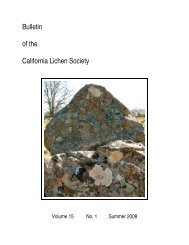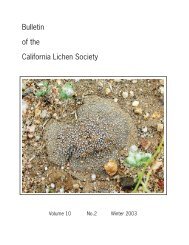Volume 10(1): Summer 2003 - The California Lichen Society (CALS)
Volume 10(1): Summer 2003 - The California Lichen Society (CALS)
Volume 10(1): Summer 2003 - The California Lichen Society (CALS)
Create successful ePaper yourself
Turn your PDF publications into a flip-book with our unique Google optimized e-Paper software.
Bulletin of the <strong>California</strong> <strong>Lichen</strong> <strong>Society</strong> <strong>10</strong>(1), <strong>2003</strong><br />
in the city and is considered by Galloway to be<br />
probably a non-native species “whose range has<br />
been greatly increased by man and his activities.”<br />
At the edge of the city Pseudocyphellar ia cf. crocata<br />
does well on the pavement with Xanthoparmel ia<br />
scabrosa. <strong>The</strong>re is even a common urban Usnea, the<br />
“intensely polymorphic” U. arida, which appears to<br />
belong to the U. fragilescens aggregate (Clerc 1987,<br />
p. 487 ff.). It reaches about <strong>10</strong> cm on trees in gardens<br />
here.<br />
Far and away the most remarkable urban<br />
lichen, however, is Xanthoparmelia scabrosa. I am<br />
reproducing here my posting on this species to the<br />
Honolulu lichen listserver in an edited version:<br />
Fig. 8. Cladon ia subula ta,<br />
Wright 7434. 0.6×.<br />
the street on the tile roof of St. Michael’s Church,<br />
Cladia cf. schizophora (fig. 9 and note 2) mingles with<br />
Xanthoparmel ia scabrosa. Downtown along a freeway<br />
exit Xanthoparmel ia mexicana, a species, indeed a<br />
genus, which <strong>California</strong>ns know only from rock,<br />
does well on a wooden fence rail; it is reported also<br />
from bark by Galloway (1985). Parmotre ma chinense,<br />
which I associate with comparatively clean coastal<br />
environments in <strong>California</strong>, is frequent on plantings<br />
Fig. 9. Clad ia cf. schizopho ra,<br />
Wright 7401. 9×<br />
Xanthoparmelia scabrosa is a finely isidiate species<br />
with a very interesting and complex secondary<br />
product chemistry (scabrosins, sulfur and nitrogen<br />
containing compounds with potent activity against<br />
human breast cancer [Ernst-Russell et al. 1999])<br />
known from Argentina, Australia, Japan, New<br />
Guinea, and New Zealand. In New Zealand it has,<br />
at least by the standards of western North America,<br />
a remarkable distribution, on which Mason Hale<br />
commented in his monograph of the genus (Hale,<br />
1990): “It is especially common in New Zealand<br />
where it even grows on pavement and sidewalks<br />
in cities.” A stronger statement could be made: it<br />
is nearly ubiquitous and frequently abundant and<br />
luxuriant, as in the city of Wellington on sidewalks,<br />
asphalt, stone walls, and rocks (figs. 5 and 6,<br />
back cover). I have seen it on glass of a window<br />
in the Kelburn district. It is downtown where it<br />
grows in some cases even where automobiles are<br />
rolling and pedestrians are treading continually.<br />
I am not aware of any equivalent phenomenon<br />
in <strong>California</strong>. T. Ahti (pers. comm., 2002) reports<br />
that there is some Xanthoparmel ia on pavement in<br />
Australia, and M. McCanna in Virginia noted by e-<br />
mail that a Xanthoparmel ia does occur on pavement<br />
of the Blue Ridge Parkway there but not as<br />
luxuriantly as shown in figures 5 and 6 on the back<br />
cover of this issue of the Bulletin. Macrolich ens<br />
(Xanthoparmel ia, Flavoparmelia, even Heteroderm ia)<br />
may rarely be found on pavement in central and<br />
northern <strong>California</strong> on unused streets in housing<br />
developments which were abandoned before the<br />
homes were built and on other little used byways;<br />
X. scabrosa, however, is ex tremely common on<br />
streets and sidewalks, including busy ones.<br />
4





